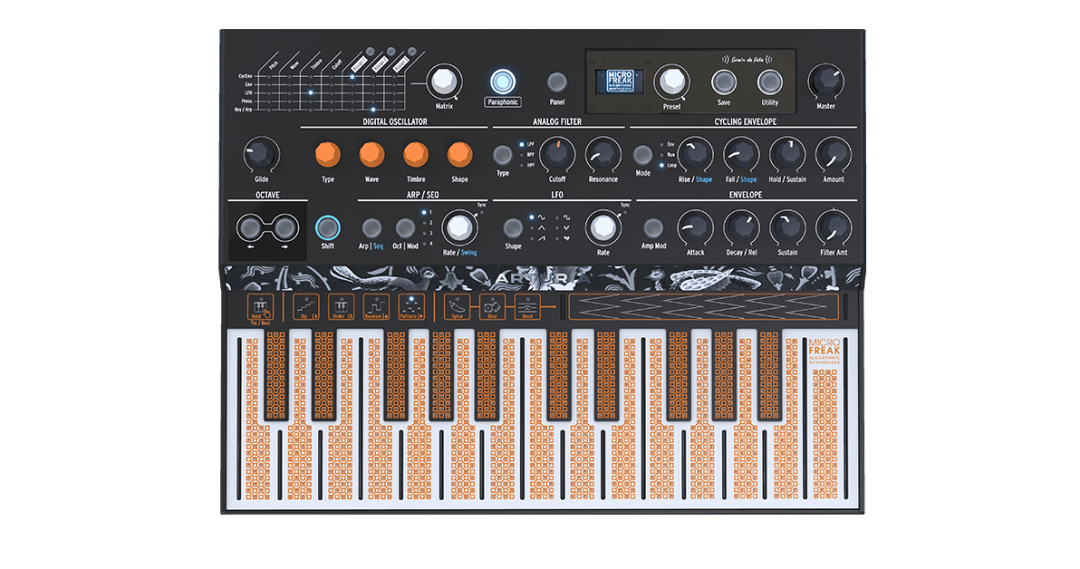The Arturia MicroFreak Hybrid Synthesizer is an exceptional piece of gear, whether you’re looking for your first affordable hardware synth, or you just want to add some unique sounds to your collection. It blends wavetable and digital oscillators with analogue filters, plus its different modes are like having dozens of instruments in one.
Overview: Arturia MicroFreak Hybrid Synthesizer
MicroFreak is a naturally monophonic synth, but you choose to enable paraphony. That means you can play up to 4 simultaneous voices, but they all share the same filter, envelope, and VCA settings.
At the heart of the instrument is the digital oscillator. It has multiple modes which can be easily switched and directly controlled with the 4 dedicated knobs in the Digital Oscillator section. The Type knob switches between the engines, while the Wave, Timbre, and Shape controls let you refine the oscillator to suit your taste.
MicroFreak currently has 16 oscillator types, covering a wide range of timbres. The added oscillators come from ongoing collaborations with modular titans Mutable Instruments and Noise Engineering. One of the great things about the Arturia MicroFreak is that it regularly receives updates, which have added oscillator modes, factory presets, user preset storage, and more.
The hybrid part of the synthesizer comes from the addition of an analogue filter. It tames some of the sharper edges of the digital oscillator, and is based on the Oberheim-desiged SEM filter.
- SEE ALSO: Arturia V Collection 8 Review
- SEE ALSO: Squarp Pyramid Review: 64-Track Sequencer
- SEE ALSO: Gifts for Music Producers
Main Features
- Synthesizer with 384 preset slots and 320 factory presets
- 16 digital oscillator modes, including engines from Mutable Instruments and Noise Engineering
- Up to 4-voice unison mode with 12-semitone unison spread
- Analog State Variable Filter, 12dB/octave, resonant, Low Pass, Band Pass, High Pass
- ADSR envelope
- Cycling Envelope offering two modes:
- Envelope
- LFO
- LFO with Sync: Sine, Tri, Saw, Square, Random, Slew Random
- Modulation matrix with 5 sources and 7 destinations (3 custom destinations)
- Monophonic or Paraphonic modes – Up to 4 voices
- Chord mode lets you program a chord shape and play it on any note
- Scale Quantize lets you set a specific scale for the white notes to simplify the creative process
- 25-key capacitive keybed with polyphonic aftertouch
- Capacitive touch strip
- Crisp OLED display for editing and parameter values
- Powerful arpeggiator
- Up, Order, Random, Pattern modes
- Spice & Dice Gate randomizers
- 64-step sequencer
- 2 patterns per preset
- 4 automation tracks per preset
- CV / Gate / Mod outputs
- USB, Clock, and MIDI in and out
- 6.35mm master and 3.5mm headphone output (TRRS input compatible for Vocoder engine)
A Divisive ‘Keyboard’
The MicroFreak’s most polarizing feature is the exclusion of a traditional keyboard. Instead of using regular keys, it has a touch-sensitive tactile interface. For most people, it’s unlike anything they’ve ever used. A flat, touch-sensitive keyboard with no moving parts is pretty foreign; it may take some getting used to despite Arturia’s best efforts to make it intuitive.
The 25-key printed circuit board not only tracks pitch, but can also detect pressure or aftertouch on each note individually. This has some exciting applications within MicroFreak itself, but also for polyphonic aftertouch-enabled virtual instruments when MicroFreak is used as a MIDI controller. The touch-controls above the keyboard also give you access to the key parameters of the sequencer, while the touch strip can be used as a pitch bender, or to control the amount of “Spice” and “Dice” in your sequences.
- Spice: Adjusting the level of Spice in your sequence literally spices it up, altering the parameters of the pattern without changing the pitch, and creating something new
- Dice: When Dice is selected, using the touchstrip randomizes your sequence by the amount you choose, letting you find inspiration from the unexpected.
It’s divisive, certainly. But it’s also pretty forward-thinking, and puts the ‘freak’ in the Arturia MicroFreak synthesizer.
Arturia MicroFreak vs. Korg Minilogue
Korg’s Minilogue pops up a lot in conversations about entry-level hardware synthesizers. While the MicroFreak is an outlier by design, made for inspiring sounds through its weirdness, the Minilogue is a more straight-ahead synth.
Its newly developed analogue synthesizer circuit delivers polyphony and full programmability at an affordable price. The Korg Minilogue is very nice 37-key analogue synth for a fraction of the cost of the big boys.
Ultimately, the Arturia MicroFreak and Korg Minilogue are different beasts entirely. But if you find yourself on the fence about choosing your first hardware synth, the Minilogue is safer, more traditional choice.
